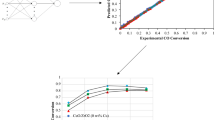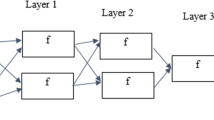Abstract
In this study, artificial neural network (ANN) and thermodynamic models were developed for prediction of the heat capacity (C P ) of amine-based solvents. For ANN model, independent variables such as concentration, temperature, molecular weight and CO2 loading of amine were selected as the inputs of the model. The significance of the input variables of the ANN model on the C P values was investigated statistically by analyzing of correlation matrix. A thermodynamic model based on the Redlich-Kister equation was used to correlate the excess molar heat capacity \( \left({C}_P^E\right) \) data as function of temperature. In addition, the effects of temperature and CO2 loading at different concentrations of conventional amines on the C P values were investigated. Both models were validated against experimental data and very good results were obtained between two mentioned models and experimental data of C P collected from various literatures. The AARD between ANN model results and experimental data of C P for 47 systems of amine-based solvents studied was 4.3%. For conventional amines, the AARD for ANN model and thermodynamic model in comparison with experimental data were 0.59% and 0.57%, respectively. The results showed that both ANN and Redlich-Kister models can be used as a practical tool for simulation and designing of CO2 removal processes by using amine solutions.












Similar content being viewed by others
References
Panwar N, Kaushik S, Kothari S (2011) Role of renewable energy sources in environmental protection: a review. Renew Sust Energ Rev 15:1513–1524
Afkhamipour M, Mofarahi M (2013) Comparison of rate-based and equilibrium-stage models of a packed column for post-combustion CO2 capture using 2-amino-2-methyl-1-propanol (AMP) solution. Int J Greenhouse Gas Control 15:186–199
Afkhamipour M, Mofarahi M (2017) Review on the mass transfer performance of CO2 absorption by amine-based solvents in low-and high-pressure absorption packed columns. RSC Adv 7:17857–17872
Borhani TNG, Azarpour A, Akbari V, Wan Alwi SR, Manan ZA (2015) CO2 capture with potassium carbonate solutions: A state-of-the-art review. Int J Greenhouse Gas Control 41:142–162
Kohl A, Nielson R (1997) Gas Purification. Gulf Publishing Company Houston, Texas
Afkhamipour M, Mofarahi M (2014) Sensitivity analysis of the rate-based CO2 absorber model using amine solutions (MEA, MDEA and AMP) in packed columns. Int J Greenhouse Gas Control 25:9–22
Smith JM, van Ness HC, Abbott MM (2005) Introduction to chemical engineering thermodynamics. McGraw-Hill, New York
Maham Y, Hepler GL, Mather AE, Hakin AW, Marriott RA (1997) Molar heat capacities of alkanolamines from 299.1 to 397.8 K Group additivity and molecular connectivity analyses. Journal of the Chemical Society. Faraday Trans 93:1747–1750
Chiu L-F, Li M-H (1999) Heat capacity of alkanolamine aqueous solutions. J Chem Eng Data 44:1396–1401
Chen Y-J, Shih T-W, Li M-H (2001) Heat Capacity of Aqueous Mixtures of Monoethanolamine with N-Methyldiethanolamine. J Chem Eng Data 46:51–55
Shih T-W, Li M-H (2002) Heat capacity of aqueous mixtures of diethanolamine with 2-amino-2-methyl-l-propanol. Fluid Phase Equilib 202:233–237
Mundhwa M, Henni A (2007) Molar heat capacity of various aqueous alkanolamine solutions from 303.15 K to 353.15 K. J Chem Eng Data 52:491–498
Weiland RH, Dingman JC, Cronin DB (1997) Heat Capacity of Aqueous Monoethanolamine, Diethanolamine, N-Methyldiethanolamine, and N-Methyldiethanolamine-Based Blends with Carbon Dioxide. J Chem Eng Data 42:1004–1006
Lin S-Y, Leron RB, Li M-H (2014) Molar heat capacities of aqueous binary and ternary mixtures (with piperazine) of two diamines: N,N,N′,N′-Tetramethylethylenediamine and N,N,N′,N′-tetramethyl-1,3-propanediamine. J Taiwan Inst Chem Eng 45:1291–1297
Shaikh IWN (2012) Molar heat capacities and heats of mixing of aqueous solutions of 2-(propylamino)ethanol, 2-(butylamino)ethanol, 1-(2-hydroxyethyl)piperidine, bis(2-methoxyethyl)amine and other alkanolamines of importance to carbon dioxide capture. Master of Applied Science, University of Regina
Poozesh S, Rayer AV, Henni A (2013) Molar Heat Capacity (Cp) of Aqueous Cyclic Amine Solutions from (298.15 to 353.15) K. J Chem Eng Data 58:1989–2000
Chen Y-R, Caparanga AR, Soriano AN, Li M-H (2010) Liquid heat capacity of the solvent system (piperazine + 2-amino-2-methyl-l-propanol + water). J Chem Thermodyn 42:518–523
Agbonghae EO, Hughes KJ, Ingham DB, Ma L, Pourkashanian M (2014) A semi-empirical model for estimating the heat capacity of aqueous solutions of alkanolamines for CO2 capture. Ind Eng Chem Res 53:8291–8301
Bagheri M, Borhani TNG, Zahedi G (2012) Estimation of flash point and autoignition temperature of organic sulfur chemicals. Energy Convers Manag 58:185–196
Afkhamipour M, Mofarahi M (2016) Modeling and optimization of CO2 capture using 4-diethylamino-2-butanol (DEAB) solution. Int J Greenhouse Gas Control 49:24–33
Pouryousefi F, Idem R, Supap T, Tontiwachwuthikul P (2016) Artificial Neural Networks for Accurate Prediction of Physical Properties of Aqueous Quaternary Systems of Carbon Dioxide (CO2)-Loaded 4-(Diethylamino)-2-butanol and Methyldiethanolamine Blended with Monoethanolamine. Ind Eng Chem Res 55:11614–11621
Aljahdali SH, Sheta A, Rine D (2001) Prediction of software reliability: A comparison between regression and neural network non-parametric models. Computer Systems and Applications, ACS/IEEE International Conference on. 2001, IEEE, pp 470–473
Vaferi B, Rahnama Y, Darvishi P, Toorani A, Lashkarbolooki M (2013) Phase equilibria modeling of binary systems containing ethanol using optimal feedforward neural network. J Supercrit Fluids 84:80–88
Fu K, Chen G, Sema T, Zhang X, Liang Z, Idem R, Tontiwachwuthikul P (2013) Experimental study on mass transfer and prediction using artificial neural network for CO 2 absorption into aqueous DETA. Chem Eng Sci 100:195–202
Cybenko G (1989) Approximation by superpositions of a sigmoidal function. Math Control Signals Syst 2:303–314
Acknowledgments
We thank the Persian Gulf University and the Converged Energy Materials Research Center, Yonsei University for financial support, for providing various facilities, and for necessary approval.
Author information
Authors and Affiliations
Corresponding author
Ethics declarations
Conflict of interest
The authors declare that they have no conflict of interest.
Rights and permissions
About this article
Cite this article
Afkhamipour, M., Mofarahi, M., Borhani, T.N.G. et al. Prediction of heat capacity of amine solutions using artificial neural network and thermodynamic models for CO2 capture processes. Heat Mass Transfer 54, 855–866 (2018). https://doi.org/10.1007/s00231-017-2189-y
Received:
Accepted:
Published:
Issue Date:
DOI: https://doi.org/10.1007/s00231-017-2189-y




